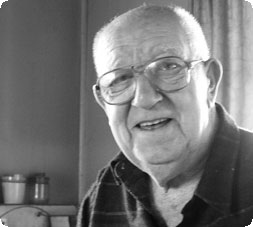 |
 |
|
Bill van NielBill van Niel was born in Holland in and came to Australia in 1950 at the age of 28. He worked in Sydney for about three months and then met a "Deni bloke" who encouraged him to "go bush". In the summer of 1951 he started work for the Water Conservation and Irrigation Commission at the Lawson Syphon, near Deniliquin, joining the maintenance crew once construction had finished. INTERVIEW TRANSCRIPTThe following text is based on an edited transcript of interviews conducted with Mr Bill van Niel in December 2004. Key topics: immigration, Aljoes Creek syphons Lawson Syphons, construction, concrete works, steam hammer, fatal accident, migrant workers, Lawson Syphon camp, dust storm I decided to go to Australia, got some papers and my next door neighbour, he wanted to come with me. It was Peter Dundon. Australia took anyone, married or not married. In New Zealand you had to have a sponsor if you was married so you got a job and a house, which they didn't do here. They just took them in, Bonegilla and then from there you had to find your own way out. And we stood down there in the, in the queue and I said to Pete "Now where you going to go, New Zealand or Australia?" because he didn't know nothing about Australia, not really and we tossed a coin, heads or tails, tails we go to Australia, heads we go to New Zealand. And tails came up and I'm not sorry about that!" We went to the Commission, we got the job and we packed our gear and got the best way out that we could and we got a blanket and a pelisse from the store. You had to pay for that, went out of your wage of course, and in the, in one of the sheds there was bales of hay and that was your bed. And two thin blankets. The Lawson Syphon camp The camp was about 3 rows of huts at 2 blokes to a hut, you had the showers, no partitions, just open and you had, you didn't have to be shy. And the toilets, the toilets was a great big, big hole with a seat on it and then the, the camp orderly he used to put oil, oil in there and burn it out and oh Jesus, that stunk. I remember one time we counted about 25 different nationalities. We had Romanian, Swedish, Danish, Nor, Norway, all the countries from Europe there was one or two different there but they didn't stay long they just came in and made a quid and off they go again. And then some of the blokes they got married and the Commission, they supplied the timber and the cement and they supplied the material and you could build a little, little house down there and you had a block, and you know pay the peppercorn duty. A big bloody hole [When I arrived there was only] those two pipes, right in the riverbank. The rest was a great big bloody hole. Those two pipes, they only [made] inside of there, off the forms – absolutely pure two big blocks of concrete. The escape, that little structure what fills the Edward River and that goes to Stevens Weir was there. At the end of the [Mulwala] Canal, before it went into the Syphon, that in there was a timber structure, like that with a slope was filled in with dirt like you know, and when the Syphon was finished well they pulled that out and that, that started it off. The river was put off one way, what they call the coffer dam. And then when that side was finished well they put the coffer dam down [the other side]. You start from the top and coming down and then of course later on when, when the business was going, you had to use the outside forms on, to build the pipes up. You just used to have to put the two forms together, no fronts on it, and those blokes had to work real bloody hard. We all did because well if you can image we used about 2,000 packs of cement a week. It's amazing the amount of steel that went in the reinforcement. It was all bars, yeah, inch and an inch and a quarter, and four inches of pipe and that was, an enormous amount because there was one gang done nothing else but bending the steel like you know they you get the steel bar and they had to go in that form and we used three to go around the thing. One, two, oh about three because I didn't have much to do with construction because I was off with the concrete. But it was hard work but it was very satisfying. You, you made something. Aljoes Creek syphons The Aljoes Creek was all ready. The piles were in and everything like that it was ready to go and then the war, apparently the war started and they stopped the whole lot. You got all them great big steel piles, it had a groove in it, and the groove in it, one's fitted in the other, and that was under Aljoes Creek, that was already there when we came down there. I can't remember how wide it was, oh about 40, 40 feet across like, and there was big young timbers from one side to the other, well you might as well, big logs, they were not rotten but the weather had eaten in it so they all had to be cleaned first. I came in the concrete gang and I was lucky enough to get the mixer driver job. It was very intriguing sort of a business and I watched them all the time. When you started the compressors up, you started a quarter of an hour earlier than the rest so everything was ready to run and I was always early at the job like and I stood behind [the operator Frank McLeod] and one day he turned up sick and the foreman, Ron Butcher, tough tough bloke but a good bloke. And Butcher goes Jesus Christ what we gonna do, he said the whole business, the mixers and the things like that, if that stopped everything else stopped as far as the concrete gang was concerned. And I said to Ron, I'll have a try. I pushed one clock, one thing, that light went on and I tried other one, put the other one on, give it a push and away she went. An experiment [I helped pour] every bit of the Aljoes [syphons].The first part we poured well everything was staged for everyone and it, I think we worked about 24 hours. It got better and better as time went on because, well it was more or less for most people, even engineers, it was an experiment. Like, you know, at the first bell you pour, well with Muryphy's Law anything that will go wrong will go wrong. And I don't know how long it took but later on we took about 5, 5 and a half hours to finish one [pouring one section]. And isn't it funny the noise when they were still going at the Aljoes Creek and we lived oh maybe a couple of metres, wouldn't be any more where we were, and at night time when was on night shift, bang, bang, bang, bang, bang the steam hammer and yet, it was only a couple of days and you slept through it. If it stopped there was something wrong, then you woke up. [The steam hammer] was a great big block of steel and with valves in it and the valves went up and down so every time you all those piles oh gosh, there must have been I don't know how long they were, they might have been 30, 30 feet because you couldn't lift them and there was a groove in them. Sometimes in the dirt they went, they went down 4 or 5 or 6 feet without touching it and then they put the hammer on top and then belted it down. Injured and killed One of the pile frames fell down and a bloke named Oliver and a boy Jones they got killed. But Tommy Hall, Tommy was very lucky he only came off with a broken hip or something. Yeah, another bloke was killed, we started working in shifts. Before it was only an 8 hour day, but we start 2 shifts and the in the long run to hurry it up we got 3 shifts and that poor man . . . Where the timbers go across and there was gang planks laying on and a dragline was, working there and he hit one of the barrier planks, and the barrier plank shot up – it was big to wheel your wheelbarrow over. It was about a foot wide and about 3 inches thick and about 20 feet long so it was, it was a fair lump of timber. And when I saw the dragline driver hit the thing it was an accident, a pure accident, and all the boys run that way, he was the only bloke that run the other way [and was struck by the falling timber]. And another thing what happened one time, we had a dust storm and Aljoes, it was on the Aljoes Creek, and it was nearly finished and the dust came down, oh something awful and the lot of the Italians they went down, laying down for shelter in the pipes and you know what happened? The Aljoes Creek was nearly finished, it looked like a chimney, and some blokes were lucky that they had a coat on because it was summer time so they could save themself, which some of them came out they were in a bad way. That is from the dust like, you know, it was like a chimney the dust comes in and you got 2 great big bloody holes an shoooo! Out of the darkness One time in the afternoon, just before the opening, we had some light in [the syphons] there to clean up, three of us in the Sunday afternoon. You get a certain amount of daylight going down [into the syphons] but where you was in the centre you, you could hold your hand like that, you couldn't see. Even if you, if you close your eyes you get a certain amount of daylight. Imagine that you can't see absolutely nothing but blind people they don't get nothing and that's how it was. But after that the lights went out - and we knew there was nothing you could fall over - we start walking and you walk in the pipe so you couldn't step one way or the other, gravity pull you right to the middle and you get frightened. You knew nothing would happen but still you got nervous. I never forget that. |
You'll need to get the Flash Player to hear the audio. |
|
| sitemap • credits
& references • copyright • local
history links • contact & contribute • VISITORS |
||
